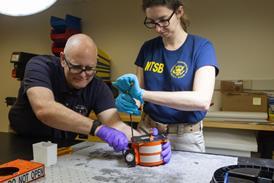Paul Seidenman/SAN FRANCISCO

Dassault has completed the installation of the latest version of a state-of-the-art digital design system at its Falcon Jet Completion Center at the Little Rock National Airport in Arkansas. The system, CATIA R, was originally developed in the mid-1980s by the French aircraft builder.
The system uses three-dimensional (3-D) graphics and is applied to the interior design of each Falcon completed at Little Rock, where most of the aircraft - which come off the Bordeaux assembly line in a green configuration - are completed. This newest version of CATIA, in combination with extra manpower and further refinements of the company's production process, will enable the facility to complete 57 aircraft this year, according to Jim Aldrich, vice-president for engineering of Falcon Jet Little Rock. "This is an increase of 20 aircraft over 1998. We expect our production rate to reach 60 next year," he says.
Implementing CATIA, Aldrich explains, has been an "evolving and progressive process", starting in 1986 when the software was first deployed. The system then was confined to producing two-dimensional graphics. "In fact, we were using two-dimensional graphics as recently as three years ago, but, even then, we were starting to incorporate a limited amount of 3-D," he says.
"It was not until 1998 that we began using the latest version of CATIA, which has a total 3-D modelling and design capability called '3-D Solids.' That allows our designers to see the dimensional mass of all items going into the interior. As a result, the drafting boards and pencils have gone, and all of the design work is done using the computer. This has taken a lot of the guesswork out of aircraft design. And, because the design is in digital form, all of the data is fully transferable to Dassault in France, electronically," he adds.
By this September, 75 interiors had been created at Falcon Jet Little Rock, using the software's 3-D graphics capability. "We essentially phased in the use of 3-D graphics during 1998, using the software mostly for the design of the cabinetry for the first 55 aircraft," Aldrich says. "But, for the last 20 aircraft, we have applied it to the complete interior package, including electrical wire routing, oxygen lines, avionics and plumbing."
Although the overall flow time of an aircraft completion - about three months - is largely unchanged from that of a year ago, production times for major portions of the interior completions have decreased overall. "We are still on a learning curve, but we have been able, for instance, to reduce cabinet production times by as much as 50% in some cases, with 30% a good average," Aldrich reports.
CATIA is distributed under a partnering deal between Dassault Systemes and IBM, which supplies the RISC 6000 desktop workstations. These are linked by a local area network (LAN) to a main server. At Little Rock, 79 individual workstations are linked to the LAN, serving 140 design engineers. "The LAN allows us to do concurrent engineering," says Aldrich. "This means that, as the models are developed, any person - at any one of the workstations - can call up the model and modify it for use for any individual customer."
Basic design groups
There are three basic completion design groups: cabinetry, avionics, and support systems (which includes wiring, plumbing, oxygen and air conditioning). All can use the CATIA system simultaneously. "We are using three software programs that were developed for application to specific portions of the interior design. These programs have been advanced to the point where even the smallest details of the aircraft's interior are designed digitally," Aldrich says.
The newest of the three special applications - FURNITUR - was created specifically for cabinet design work by Dassault, and is used solely at the Little Rock centre. It provides what Aldrich calls "a lot of extra software tools" for cabinet design.
"FURNITUR has given us more capability, including greater speed with the design process. As details are modified, the software automatically takes into account how those changes will affect other parts of the cabinet's design, such as a drawer or a panel. If necessary, it will make any appropriate changes. Before FURNITUR, the designer himself had to go back and input those changes."
Aldrich adds that FURNITUR can account for "the largest and smallest detail" of every item. For example, the system will consider the unique requirements of what the owner intends to store within the cabinets, such as glassware or china. "Using that information, the designer can develop cabinetry that can safely store any items, based upon their weight and breakability."
For the electrical system, CATIA employs E3D software, which provides a detailed 3-D rendering of the interior wiring as the electrical system is designed, while the plumbing system designers use a 3-D program aptly called PIPING (below).

Both applications are used at Little Rock under licence from IBM. "The E3D can predict any potential wiring problems, such as sagging, or an unsafe bending radius," Aldrich says. He adds, that, along with cabinetry and support systems, the interior designers can also apply the software to the installation of seating and carpeting, as well as soundproofing systems, data ports and electrical outlets and entertainment and food service systems. And, once the design is fully built up, the layers of the aircraft's "virtual interior" can be stripped away so that the designers can view the location of all hidden systems, such as wiring and piping.
Aldrich says that the most recent addition to the design capabilities at Little Rock is a portable co-ordinate measuring machine (CMM), which can be used in tandem with the CATIA system. The CMM, which is small enough to fit on a desk or to bring aboard an aircraft undergoing modification, allows the designer to measure precisely all surfaces, from the cabinetry to the glassware and china it would store. This is done by moving a tool attached to the CMM over all edges of the object to be measured. As this is done, the CMM automatically computes all the co-ordinates in 3-D. The CMM is taken to the CATIA workstation, and the information it has generated is transferred. "By using the portable CMM, the designer is able to see how even the smallest items will fit into cabinets and other spaces. Before, all of this information had to be computed manually," says Aldrich.

Falcon Jet Little Rock also uses a system called ALIAS, which creates a photographic-quality image of the aircraft's cabin. The user can add colours, textures and shadow to see how the interior would look under different lighting effects. As Aldrich notes, CATIA has given the Little Rock centre another advantage that goes well beyond the design phase.
"Anything that can be stored in digital format can also be transferred to the router machines, which use the data to cut precisely the panels used in the interior of the aircraft," he says. "This includes bulkhead panels, cabinets, drawers and even the fasteners. Until recently, the cutting process for all of those items had to be done by hand."
Major training investment

Aldrich says that Falcon Jet has made a major investment in training to enable the designers to use the CATIA system. "We plan to put all of our engineering staff through CATIA training," he says. "But, even with the investment we are making in training costs - as well as equipment - we expect that automation will reduce manufacturing costs and production man-hours in the long run, because we are industrialising our approach to aircraft interior completions. In the past, we built up aircraft interiors one at a time. But CATIA allows us to do aircraft completions in large quantities. This will enable the completion centre to stay on a high production schedule, and meet our goal of completing 60 aircraft at Little Rock in 2000," Aldrich adds.
Meeting that production goal has meant a ramp-up in production facilities and staff. Aldrich notes that, in 1997, when 30 aircraft were completed, Little Rock had a total staff of 900 and 27,870m² (300,000ft²) of physical plant. To prepare for the goal of 60 completions next year, the facility will be increased to 46,450m2 by the end of this year, and employ about 1,500.
As Aldrich points out, Dassault undertook the enhancements at Little Rock to keep it ahead of the demand for its product. "We saw the recovery of the business jet market coming and realised that there would be a large customer base with a preference for the Falcon Jet," he says. "With that in mind, we did not want the completion process to bottleneck. That's why it was important to build up and advance the use of CATIA. As it turned out, the Falcon Jet line is the only one at the top end of the [business jet] market that was not caught off guard as orders surged for aircraft in that size range."
Source: Flight International























